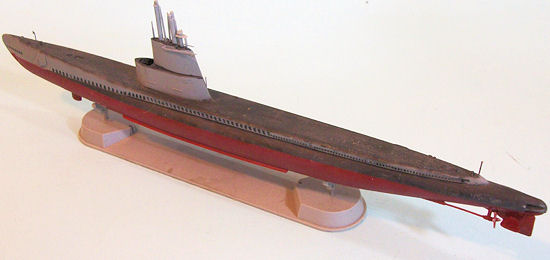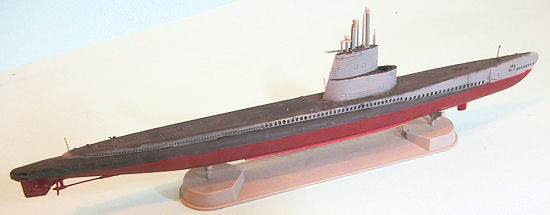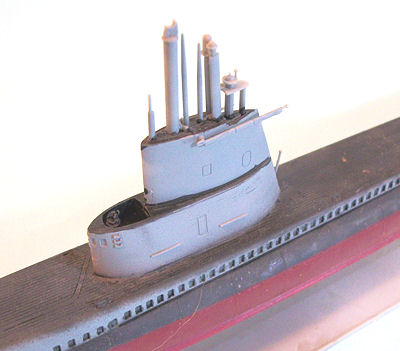AFV 1/350 Guppy IB "USS
Dace"
|
KIT #: |
AFV 73512 |
|
PRICE: |
$27.91 on sale at HLJ |
|
DECALS: |
None |
|
REVIEWER: |
Tom Cleaver |
|
NOTES: |
|

USS Dace (SS‑247), a Gato class submarine, was launched on
April 25, 1943
(sponsored by Mrs O. P. Robertson), and commissioned on
23 July 1943.
USS Dace cleared
Brisbane
on
September 1, 1944,
for her fifth and most successful war patrol.
On October 14 she joined forces with USS Darter (SS-227) off the
Palawan
Passage in the western
Philippines
to scout for the Japanese Navy, which was expected to sortie following the
invasion of the
Philippines
at
Leyte
on October 17. Shortly after
midnight
on October 23, she picked up ships in the
Palawan
Passage on radar. This was Admiral
Kurita’s Center Force: 5 battleships, six cruisers and twelve
 destroyers,
the most powerful Japanese surface force to ever put to sea.
They were enroute to cross the
Sulu Sea
and enter
San Bernardino
Strait,
to attack the invasion fleet in
Leyte Gulf
on October 25. Dace sent off
her contact report, which set in motion what came to be known as The Battles of
Leyte Gulf, and was ordered by Darter’s CO to prepare for a pre-dawn
surface attack. In a feat of skill
and courage which brought both submarines the Navy Unit Commendation, both
closed the task force; Darter attacked first, sinking Admiral Kurita’s flagship,
the cruiser Atago and damaging the cruiser Takao. Dace
followed with a torpedo attack that sank the cruiser Maya, then both went
deep to avoid the destroyers. Once Kurita was fished out of the ocean and back
aboard his new flagship Yamato, he ordered two destroyers to accompany
Takao back to port. That night
the two submarines worked through the treacherous Palawan Passage in an attempt
to sink Takao; Darter ran aground on the Bombay Shoal.
With enemy ships nearing, Dace evacuated Darter’s crew,
then attempted to destroy the submarine by torpedo unsuccessfully.
The wreck of the Darter can still be seen today on Bombay Shoal.
destroyers,
the most powerful Japanese surface force to ever put to sea.
They were enroute to cross the
Sulu Sea
and enter
San Bernardino
Strait,
to attack the invasion fleet in
Leyte Gulf
on October 25. Dace sent off
her contact report, which set in motion what came to be known as The Battles of
Leyte Gulf, and was ordered by Darter’s CO to prepare for a pre-dawn
surface attack. In a feat of skill
and courage which brought both submarines the Navy Unit Commendation, both
closed the task force; Darter attacked first, sinking Admiral Kurita’s flagship,
the cruiser Atago and damaging the cruiser Takao. Dace
followed with a torpedo attack that sank the cruiser Maya, then both went
deep to avoid the destroyers. Once Kurita was fished out of the ocean and back
aboard his new flagship Yamato, he ordered two destroyers to accompany
Takao back to port. That night
the two submarines worked through the treacherous Palawan Passage in an attempt
to sink Takao; Darter ran aground on the Bombay Shoal.
With enemy ships nearing, Dace evacuated Darter’s crew,
then attempted to destroy the submarine by torpedo unsuccessfully.
The wreck of the Darter can still be seen today on Bombay Shoal.
Dace
completed seven war patrols in the Pacific War and was at Saipan preparing for
her eighth when the war ended.
During the Second World War, Dace was credited with sinking 28,689 tons
of Japanese shipping.
With the end of hostilities, Dace was went to New London, where
she was placed in reserve at Portsmouth Naval Shipyard on January 15, 1946, and
was towed to New London, where she was placed out of commission in reserve on 12
February 1947.
 Recommissioned
on August 8, 1951, Dace operated with the Atlantic Fleet until placed in
reserve at New London on December
31, 1953. She was given extensive modernization to GUPPY 1B standard at
Portsmouth Naval Shipyard and was
recommissioned on October 22, 1954. After training men of the Marina Militare,
she was decommissioned on January 31, 1955, and transferred the same day to
Italy under the Military Assistance Program.
Recommissioned
on August 8, 1951, Dace operated with the Atlantic Fleet until placed in
reserve at New London on December
31, 1953. She was given extensive modernization to GUPPY 1B standard at
Portsmouth Naval Shipyard and was
recommissioned on October 22, 1954. After training men of the Marina Militare,
she was decommissioned on January 31, 1955, and transferred the same day to
Italy under the Military Assistance Program.
Dace was commissioned in the Marina Militare Italiana as
Leonardo da Vinci (S‑510). Originally on loan for five years, this was
extended another five years in 1959 and extended for yet another five years,
twice. Together with Enrico Tazzoli (S‑511) (ex‑USS Barb SS‑220),
Leonardo da Vinci formed the backbone of Italian submarine strength from
1955 to 1972, when she was returned to the U.S. Navy. Dace was stricken
from the Naval Vessel Register on 15 October 1972. Dace was sold for
scrap on April 1, 1975.
This is one of a series of five U.S. Fleet Boats released by
AFV
Club that allow a modeler to create representative examples of Gato-class
submarines in all their iterations from pre-war through wartime configurations
to two of the three major post-war redesigns.
This Guppy-1B represents the earliest of the post-war redesigns with the
low sail.
As with the other kits, construction is easy, but be careful not to lose
the vary small parts, which are very small indeed.
Assembly is straightforward, as is the case with most submarine models.
Dace/Leonardo Da Vinci was painted in the haze-grey submarine scheme
originally developed during the Second World War.
I painted the lower hull Tamiya “Hull Red,” then painted the upper area
of the ballast tanks Tamiya “Flat Black” and the deck Tamiya “NATO Black”.
I used Tamiya “RAF Ocean Grey” for the upper works.
 I think the US Fleet Boats in all their iterations are among the
best-looking submarines ever, and could easily do several more of the World War
II versions, modifying them to do various boats, since no two were really alike.
This 1/350 kit is nicely detailed and certainly doesn’t take up the room
of the Revell monster. Highly
recommended to submarine fans.
I think the US Fleet Boats in all their iterations are among the
best-looking submarines ever, and could easily do several more of the World War
II versions, modifying them to do various boats, since no two were really alike.
This 1/350 kit is nicely detailed and certainly doesn’t take up the room
of the Revell monster. Highly
recommended to submarine fans.
Review Kit
courtesy HobbyLink Japan: order yours
here.
Tom Cleaver
November 2012
If you would like your product reviewed fairly and fairly quickly, please
contact
the editor or see other details in the
Note to
Contributors.
Back to the Main Page
Back to the Review Index Page


 destroyers,
the most powerful Japanese surface force to ever put to sea.
They were enroute to cross the
destroyers,
the most powerful Japanese surface force to ever put to sea.
They were enroute to cross the  Recommissioned
on August 8, 1951, Dace operated with the Atlantic Fleet until placed in
reserve at New London on December
31, 1953. She was given extensive modernization to GUPPY 1B standard at
Portsmouth Naval Shipyard and was
recommissioned on October 22, 1954. After training men of the Marina Militare,
she was decommissioned on January 31, 1955, and transferred the same day to
Italy under the Military Assistance Program.
Recommissioned
on August 8, 1951, Dace operated with the Atlantic Fleet until placed in
reserve at New London on December
31, 1953. She was given extensive modernization to GUPPY 1B standard at
Portsmouth Naval Shipyard and was
recommissioned on October 22, 1954. After training men of the Marina Militare,
she was decommissioned on January 31, 1955, and transferred the same day to
Italy under the Military Assistance Program.
